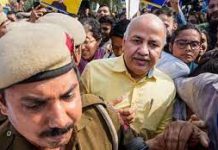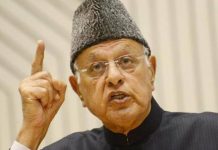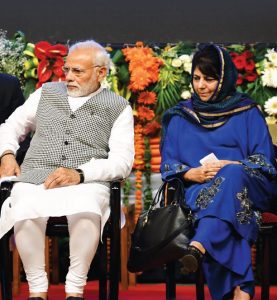 PDP-BJP coalition was not in the abruptness of the development but in the BJP choosing to do it. It was always taken for granted that if the coalition was ever going to come apart, it would be because of the withdrawal of the support by the PDP. This thinking was based on a solid rationale: The alliance with the PDP had enabled the BJP to become a ruling party in India’s only Muslim majority state, an otherwise improbable prospect considering the party’s aggressive Hindu nationalist credentials and implicit antagonism towards Muslims.
PDP-BJP coalition was not in the abruptness of the development but in the BJP choosing to do it. It was always taken for granted that if the coalition was ever going to come apart, it would be because of the withdrawal of the support by the PDP. This thinking was based on a solid rationale: The alliance with the PDP had enabled the BJP to become a ruling party in India’s only Muslim majority state, an otherwise improbable prospect considering the party’s aggressive Hindu nationalist credentials and implicit antagonism towards Muslims.
Confined largely to Hindu majority districts of the Jammu province, the BJP on its own can hardly hope to secure a majority and depends sorely on support from a state-level party to become a part of the government. But considering the BJP’s hardline ideological position on the state, a J&K party dependent on the support from Muslim majority is instinctively loath to partner with it. Such an association is deemed to be potentially detrimental to the electoral chances in the Valley. So, when the PDP partnered BJP to form the state government in 2015, the decision went against the conventional political wisdom in the state: two ideologically antithetical parties, with divergent policies on the state, choosing to join hands to rule the state.
Was power the glue that held the two together? It was but there were other powerful factors that left them little choice. PDP-BJP coalition was the best possible ruling arrangement for the state. With BJP almost sweeping the Hindu majority Jammu by securing 25 seats in 87-seat Assembly, a new state government could only have left it out at its own peril. For, this would not only have kept an entire region out of its due share in political power, a trigger for a destabilizing regional discord, but also then a resurgent BJP backed by its own majority government at the centre. More so, when the prevailing political trends in the country pointed to the BJP getting only stronger by the day and becoming more influential on the national scene.
PDP, the largest single party with 28 seats, could also go with the Congress, an ally from the party’s previous stint in power from 2002-08. But it would have still needed the support of four more legislators to secure the requisite majority of 44 to form the government. Also, a PDP-Congress alliance, apart from its abstract logic of both being secular in their outlook would hardly have been in a position to deliver. Congress, despite also being a Jammu-centric party in the state, had got only two of its 12 seats from the province. In fact, a majority of its seats came from Kashmir Valley. So, a PDP-Congress coalition government would have made the consequent state government largely Kashmir-centric, an avoidable situation in a state comprising three distinct geographic and cultural regions.
Ditto for an alliance with the National Conference, once a pan-J&K party, now largely confined to Kashmir.
Thrust together by the nature of the electoral verdict, mutual convenience, and not to mention the lure of power, the PDP and the BJP had set about forging terms of their engagement which became known as the Agenda of Alliance. On paper, the agenda seemed to make an eminent sense. It obliged the BJP not only to provide more means for the development of the state but also committed it to take steps towards resolution of Kashmir by holding talks with Pakistan and the separatists.
The coalition government was formed and rest as they say is history. From the day one, the government got off to a rambunctious start. While the issues of governance took back seat, the ideological tug-of-war moved to centre stage. The contradictions and the conflict only grew by the day, much of it to the detriment of the PDP in the Valley.
The BJP being the disproportionately more powerful party could always get away with an ideological overreach — albeit, on sensitive issues like the Article 370 and Article 35A, citizenship of West Pakistan Refugees, etc. the two parties managed to maintain an uneasy trade-off. The BJP also worked to secure a larger say in the governance. So, it was always presumed that if push came to shove, it would be the PDP which would take a bow.
But that didn’t happen. Counter-intuitively, it was the BJP that walked away. And adding further insult to the injury, waved bye to the PDP from New Delhi.
What made the development further inexplicable was that there was apparently no discord between the parties. Though privately the PDP wanted an extension of the ceasefire, it hadn’t made any public demand to the effect, nor had objected to the union government calling it off. In fact, Mehbooba had blamed militants and separatists for not reciprocating the gesture from the centre. In several statements, she had called on the Hurriyat to respond to the talks offer from the centre. She also appeared to be ready to play along with the centre’s recourse to hardline policy on the state.
Pulling the rug out
 On June 19, Mehbooba as J&K Chief Minister was sitting in her office on the third floor in Kashmir’s civil Secretariat when news of the withdrawal of support by the BJP started trickling in, first as a rumour, then as a tentative story in some newspapers followed by the sudden confirmation. Mehbooba had just finished an official meeting when the then Chief Secretary B B Vyas informed her of the development after receiving a call from the Governor N N Vohra, who, in turn, had received a faxed letter from the BJP. Mehbooba immediately decided to resign. She headed to her residence at Gupkar, held a meeting with her party leaders and later at a press conference said she was not surprised.
On June 19, Mehbooba as J&K Chief Minister was sitting in her office on the third floor in Kashmir’s civil Secretariat when news of the withdrawal of support by the BJP started trickling in, first as a rumour, then as a tentative story in some newspapers followed by the sudden confirmation. Mehbooba had just finished an official meeting when the then Chief Secretary B B Vyas informed her of the development after receiving a call from the Governor N N Vohra, who, in turn, had received a faxed letter from the BJP. Mehbooba immediately decided to resign. She headed to her residence at Gupkar, held a meeting with her party leaders and later at a press conference said she was not surprised.
“Our alliance was not for power but for the good of Kashmir. It had a bigger objective. We made unilateral ceasefire possible, Prime Minister (Narendra Modi) went to Lahore, we withdrew cases against 11,000 youth,” she told reporters.
Mehbooba also said the coalition with the BJP was for safeguarding the J&K’s special constitutional position within Indian Union. “In our four years with the BJP, we did everything to protect the Article 370 and Article 35A. We robustly defended the constitutional provisions in the Supreme Court,” she said.
But her efforts to validate the alliance found fewer takers in Kashmir. On the contrary, Kashmir rejoiced over the break-up. The social media and the Whatsapp overflowed with the exultant and satirical posts and memes over the development.
For a majority of people, it was a deserved comeuppance for Mehbooba’s rough-neck dispensation which had presided over “killings and mass blindings” in the state. Many people started posting report cards of her government.
One such post quoting from the official and unofficial estimates blamed her for killing, “235 civilians and 460 militants,” partially or completely blinding “1050 persons” and arresting around “16000 people.” She was also blamed for slapping Public Safety Acts on “countless people,” making thousands of illegal appointments and what is more, “bringing RSS to Kashmir.”
“Perhaps the first-ever break-up that the people in the Kashmir Valley will enjoy to the hilt,” posted the commentator Gowhar Geelani on his Facebook. “This break-up will not break hearts, but will bring joy and smiles on the faces of pellet-hit people”.
“Today every Kashmiri is happy This woman used Hurriyat card during elections to be in power but what she did we people will never forget,” wrote one Abdul Hamid in response.
The widespread rejoicing was largely borne out of a deep sense of betrayal of her longstanding political agenda, compounded by her government’s acquiescence to a militaristic response to the situation in the state. It was also against the perceived transformation of Mehbooba from a firebrand Kashmiri nationalistic leader to a tame Chief Minister always ready to do the bidding of the BJP.
In the altered popular opinion, Mehbooba for all her Kashmir-centric political credentials shading at times into soft-separatism had turned out to be a weak defence against the BJP’s perceived nationalistic overreach. Instead, the pressure of a coalition with the BJP had forced her to vacate the political middle-ground her party had come to occupy since its founding in 1999.
She had played down her pro-Kashmir resolution agenda and offered little counter-narrative to balance her partner’s shrill Hindutva noise. In the consequent atmosphere of grievance and fear in the Valley, Mehbooba was thus seen on the side of the tormentor.
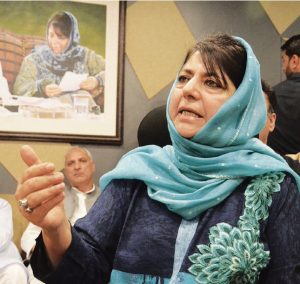
BJP Gambit
Why did the BJP do it? More so, when the state government had still two years to go before the fresh polls and the general elections were a full eleven months away? The statements issued by the BJP leaders following the decision to withdraw support adumbrate the rationale for doing it. The BJP General Secretary and the architect of the PDP-BJP alliance cited the spike in militant activities including killing of the journalist Shujaat Bukhari, radicalisation as the reasons for pulling out of the government.
Similarly, state spokesperson for the BJP Sunil Sethi said the break-up was the result of “the insistence of the PDP for extension of the period of suspension of operations and soft approach towards militants, Pakistan and separatists” which hurt nationalistic sentiments not only in Jammu and Kashmir but across the country.
“Now is the time for an all-out war against militants and their supporters and give them no place to hide and run,” Sethi said.
As if to reinforce this idea, the day after the coalition government fell, a video clip showing a two storey house in South Kashmir being blown up to smithereens mysteriously surfaced online and went viral. It was read as a message of what was to come.
The general opinion is that the alliance was broken because the BJP thought that continuing with it was not politically helpful for it in the run-up to the general elections next year. More so, with the situation getting worse by the day and the PDP apparently putting hurdles in an all-out assault against militants — albeit few in the Valley would believe that the PDP was a problem. In the more than three years that this coalition was in power, the response to militancy has been irredeemably hardline.
According to the Union Home Minister Rajnath Singh, a total of 619 militants in Jammu and Kashmir have been killed in past four years of the Narendra Modi-led government killed.
“The number of militants killed in the previous UPA-II government was 471,” the home minister said in May during an interaction with the reporters.
Last year alone, 2018 militants were killed in gunfights with security forces, highest in the preceding seven years. But despite these record killings, the militancy in the Valley has only grown from strength to strength. Between January 1 and May 31, around 90 new recruits have joined the ranks of militants in South Kashmir. The total number of militants in the Valley is estimated to be around 280.
So a fresh all-out assault is hardly expected to make any redeeming difference, unless the effort is backed by a credible political outreach to the Valley geared to the address the factors underpinning the violence.
But that is unlikely to happen during an election year. More so, when Modi government has made it impossible for itself to establish such an outreach by its rigid and maximalist ideological position on the state. So, the gambit seems to be like this: Blame the PDP for the abject failure of the four years in Kashmir.
Mount a fresh all-out operation against the militancy, stack up an impressive figure of fresh militant fatalities alongside civilian collaterals, and hope to bring the situation under control by the time elections are around and sell it as an achievement.
But as has been the case in Kashmir, the situation may not play according to script. Instead, repression could lead to more alienation and anger and more militancy — a perpetuation of the ongoing bloody roundabout.
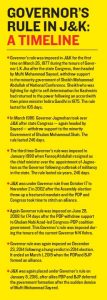 Fallout
Fallout
There are many ways of looking at the short and long term fallout of the break-up of the coalition. In Kashmir, while the BJP’s withdrawal of support has come as a vicarious fulfilment of a public desire for retribution against the PDP for its perceived betrayal of the public mandate, a parallel narrative connects the development to the New Delhi’s familiar recourse to toppling governments in the state, beginning with that the legendary Kashmiri leader Sheikh Mohammad Abdullah in 1953. The government of Sheikh, then the Prime Minister of J&K, was summarily dismissed in 1953 for his alleged hobnobbing with the US government in pursuit of an independent Kashmir. This has bred a popular discourse that New Delhi inherently doesn’t trust Kashmiri parties with handling the state of affairs and that it would rather prefer manipulating the democracy in the state than allow it a free run.
But the current development is more complex – albeit in some of its aspects it is of a piece with the centre’s attitude towards the state. An example from the past that comes closest is the withdrawal of support to Sheikh Abdullah by Congress in 1977. Sheikh had returned to political mainstream just two years before that. Another example, and it is not about pulling out of the support, is the summary dismissal of the Sheikh’s son, Dr Farooq Abdullah’s government in 1984. This time the government fell when a breakaway group within National Conference defected to form a government with Congress support. But while on both these occasions, Kashmiris supported the incumbent parties and their anger was directed against the centre, this time they have celebrated the fall of the government.
So, how is the latest unceremonious ouster of a Kashmiri leader going to play out. It is clear from the anger directed against Mehbooba that the repercussions will be unlike those in the wake of similar developments in the past. But repercussions there will be, nevertheless. One possible outcome could be that the B JP in future could find it difficult to get a coalition partner in the state, making it unlikely for it to return to power in the state. More so, after the party implemented the Agenda of Alliance with the PDP largely in breach.
But considering that the BJP still went ahead with the break-up shows that the party doesn’t care much about forming a future government in the state. It is clear that for BJP Kashmir is important for mobilizing political support in the rest of the country than for its own sake. So, getting to power in the state becomes secondary to using the state to get to power at the centre. BJP’s attempt has been to unite and consolidate Hindu vote bank. And the one sure-fire way to do this is to champion a hardline nationalistic policy, bordering on polarization of voters.
This has been one abiding template of the saffron politics in the country. In breaking up its own coalition government in the state, an eye on the next year’s general election appears to be the overriding motivating factor. Says the commentator Gowhar Geelani: “The fact is that for the BJP, Kashmir is a laboratory for its Hindutva project. The polarization in Jammu and muscular policy in Kashmir is being adopted with an eye on upcoming general elections.”
OTHER POSSIBILITIES
There are other possibilities in store: With the Assembly being in suspended animation, the political parties in the state have expressed apprehensions of horse-trading in the state. National Conference has demanded dissolution of the Assembly to pave way for fresh elections. The PDP fears that the BJP might poach upon its disgruntled elements to make a government on its own. Shall any of these scenarios play out in near future? There aren’t many in Kashmir that buy into this prospect.
“It is very unlikely that the BJP would resort to horse-trading, given the sensitive nature of the state,” says Naseer Ahmad, a columnist. “But if it does, the move would further undermine the democracy in the state and alienate people from New Delhi.”
The US based Kashmiri academician Dr Nyla Neelofar also warns against such a prospect.
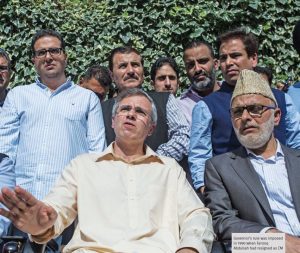
“Dismissing governments and legitimizing the practice of horse trading ends up criminalizing the electoral process and government formation,” she says. “Governments that are hurriedly rustled up and disconnected from the grassroots lack the foresight to pay attention to whether the legislation and execution of political, economic, and social policies and programs in contemporary Kashmir is successfully addressing women’s as well as men’s experiences and concerns”.
However, the possibility that a majority of the people in the state are genuinely anxious about is fiddling with J&K’s special status. One law that is critical to this status is the Article 35A which is currently being challenged in the Supreme Court. The Article 35A which was extended to the state through a 1954 Presidential Order gives protection to the state subject laws in J&K whereby outsiders are not allowed to settle or acquire property in the state.
At the press conference following her resignation, Mehbooba Mufti was quick to point this out. Among her achievements she touted the defence of the Article 370 which gives J&K its special constitutional position within Indian Union and also that of the Article 35A, one of its critical features.
Should the BJP succeed in tampering with the provisions, or somehow the court judgement goes on to dilute them, the party can again sell it as a major triumph in the run up to the polls.
But it could throw Kashmir into turmoil and lend an even greater rationale to separatist movement and the militancy.
“The break-up of the coalition has created a fraught scenario in J&K,” says Naseer. “The BJP would be wise to remember that Kashmir is too sensitive a state to be messed with to win an election.”
letters@tehelka.com









